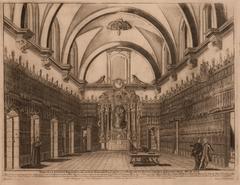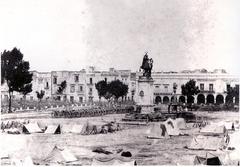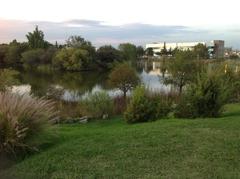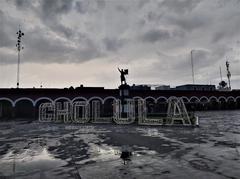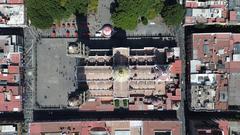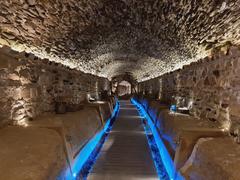Nuestra Señora de Lourdes Puebla City, Mexico: Visiting Hours, Tickets, and Historical Sites Guide
Date: 14/06/2025
Introduction
Nestled in the culturally vibrant city of Puebla, Mexico, the sanctuary of Nuestra Señora de Lourdes offers a unique blend of spiritual atmosphere, architectural intrigue, and deep-rooted Catholic tradition. Modeled after the original grotto in Lourdes, France, this sanctuary invites both locals and travelers to experience a powerful Marian devotion without leaving Mexico. Its location amidst Puebla’s rich historical landscape—surrounded by military forts, museums, and colonial landmarks—makes it a must-visit for those interested in faith, history, and culture (Poblanerías; Wikipedia).
This comprehensive guide will provide detailed insights into the history, significance, visiting hours, ticketing, accessibility, and surrounding attractions of Nuestra Señora de Lourdes in Puebla, ensuring a rewarding and well-prepared visit.
Table of Contents
- The Origins and Spread of Lourdes Devotion
- Significance and Patronage of Nuestra Señora de Lourdes
- Architectural and Cultural Context
- Visiting Hours, Tickets, and Accessibility
- Pilgrimage and Community Practices
- Liturgical Celebrations and Events
- Symbolism and Artistic Features
- Impact on Puebla’s Religious Landscape
- Practical Tips and Visitor Experience
- Cultural Etiquette
- Notable Nearby Attractions
- Frequently Asked Questions (FAQ)
- Summary and Final Recommendations
- References
The Origins and Spread of Lourdes Devotion
The global devotion to Our Lady of Lourdes began in 1858, when Bernadette Soubirous, a young girl from Lourdes, France, reported seeing apparitions of the Virgin Mary at the Grotto of Massabielle. The Catholic Church officially recognized these apparitions in 1862, catalyzing a worldwide Marian devotion (Wikipedia). Soon after, replicas of the Lourdes grotto began appearing in Catholic communities worldwide, including Puebla, Mexico, offering people a local place to connect with the Lourdes tradition.
Significance and Patronage
Nuestra Señora de Lourdes is celebrated as the patroness of the sick, a role rooted in the original Lourdes apparitions where miraculous healings were reported at the spring revealed by the Virgin Mary. The feast day on February 11 is especially significant, coinciding with the World Day of the Sick established by Pope John Paul II (Wikipedia). In Puebla, this day draws pilgrims for special Masses, processions, and blessings.
Architectural and Cultural Context
Site and Setting
Located on the slopes of Cerro de Loreto y Guadalupe in the Los Fuertes district, the sanctuary stands near two historic forts—Loreto and Guadalupe—that played a pivotal role in the Battle of Puebla (Telediario). The church’s address is Calzada de los Fuertes No. 2812, Colonia Rincón del Bosque, Puebla (Iglesias y Misas).
Grotto-Inspired Design
The sanctuary’s façade is crafted to resemble a natural rocky grotto, inspired by the Massabielle Grotto in France (El Universal Puebla). Its volcanic stone exterior and subdued interior, featuring rough stone walls and minimal decoration, create a contemplative atmosphere. Stained-glass windows filter colored light, enhancing the spiritual ambiance, while a prominent statue of the Virgin of Lourdes stands above a spring—a direct allusion to the miraculous water in Lourdes.
Construction and Heritage
The church was conceived in 1948 by Monseñor Agustín de la Cueva and completed in 1950 with the support of the local community. Its inauguration on October 29 and subsequent twinning with the Lourdes sanctuary in France reflect its enduring connection to the broader Catholic world (Telediario).
Visiting Hours, Tickets, and Accessibility
- Visiting Hours: Generally open daily from 8:00 AM to 6:00 or 7:00 PM. Hours may vary on religious holidays or during special events (Poblanerías; Paseo por México).
- Admission: Free entry for all visitors. Donations for candles or church maintenance are appreciated but not obligatory.
- Accessibility: The site offers reasonable accessibility, though some uneven terrain and steps can present challenges for visitors with limited mobility. Staff and volunteers are available to assist when possible.
- Guided Tours: Occasionally available during major festivals or by arrangement through local tour operators (Iglesias y Misas).
- Facilities: Restrooms are available in the surrounding park area; vendors offer religious items and refreshments outside the sanctuary.
Pilgrimage and Community Practices
Pilgrimage to Nuestra Señora de Lourdes is a vibrant expression of local faith, especially around February 11. Pilgrims participate in Mass, processions, and healing prayers, often lighting candles and offering flowers in petition or gratitude. The sanctuary also serves as a hub for charitable and community activities, supporting the sick and vulnerable (Poblanerías).
Liturgical Celebrations and Events
- Feast of Our Lady of Lourdes (February 11): Special Masses, blessings for the sick, processions, and novenas draw large crowds.
- Regular Services: Daily Masses, confessions, and other sacraments occur throughout the week (Iglesias y Misas).
- Major Festivals: Additional events during citywide festivities such as the Feria de Puebla (Paseo por México).
Symbolism and Artistic Features
The sanctuary’s iconography closely follows Bernadette Soubirous’s original description of the Virgin: white garments, blue sash, rosary, and golden roses at her feet (Wikipedia). Stained-glass windows, mosaics, and statuary reinforce themes of hope and healing, while the cave-like structure itself embodies refuge and spiritual encounter.
Impact on Puebla’s Religious Landscape
Nuestra Señora de Lourdes stands out among Puebla’s historical churches for its modern, grotto-inspired design and international Marian focus. It remains a focal point for both local devotion and international pilgrims, contributing to Puebla’s identity as a city of faith and hospitality (Poblanerías).
Practical Tips and Visitor Experience
- Best Times to Visit: Early mornings and weekdays offer a tranquil experience. Feast days and weekends are busier but rich in community spirit.
- Dress Code: Modest attire is recommended—cover shoulders and knees, particularly during services.
- Photography: Generally allowed outside Mass; always be discreet and respectful.
- Safety: The Los Fuertes area is safe and well-patrolled, but standard precautions apply (Audiala).
- Transport: Easily accessible via bus, taxi, or car. Limited parking is available; public transport or rideshare may be preferable during festivals (Voyage Mexique).
- Amenities: Food stalls and local restaurants can be found nearby. Restrooms are available in the adjacent park.
Cultural Etiquette
- Enter quietly and maintain a reflective atmosphere inside the sanctuary.
- Follow local customs such as lighting a candle or making the sign of the cross.
- Greet others politely (“buenos días/buenas tardes”).
- Refrain from eating, drinking, or using mobile phones inside the church.
- During services, follow the cues of the congregation for standing, sitting, and kneeling.
Notable Nearby Attractions
- Zócalo de Puebla: Puebla’s historic city center with colonial architecture and vibrant street life (Let’s Travel to Mexico).
- Catedral de Puebla: A magnificent example of Baroque architecture.
- Templo de Santo Domingo and Capilla del Rosario: Renowned for its gold-leaf interior.
- Callejón de Los Sapos: Famous for its antique market and artisan shops.
- Fuertes de Loreto: Historic forts central to the Battle of Puebla.
- Teleférico de Puebla: Cable car offering panoramic city views.
- Museo Amparo: An outstanding museum of Mexican art.
- Local Gastronomy: Savor mole poblano, chiles en nogada, and other local cuisine.
- Cholula Day Trip: Explore the Great Pyramid and Iglesia de Nuestra Señora de los Remedios.
Frequently Asked Questions (FAQ)
Q: What are the visiting hours for Nuestra Señora de Lourdes?
A: Typically 8:00 AM to 6:00 or 7:00 PM daily; check locally for special events.
Q: Is there an entrance fee?
A: Entry is free; donations are appreciated.
Q: Can I take photos inside?
A: Yes, outside of services. Avoid flash and always be respectful.
Q: Are guided tours available?
A: Occasionally during festivals or via local operators.
Q: Is the site accessible for people with disabilities?
A: Some areas are accessible, but uneven ground may require assistance.
Q: What is the best time to visit?
A: Weekday mornings or outside festival periods for a peaceful experience.
Summary and Final Recommendations
Nuestra Señora de Lourdes in Puebla is a testament to faith, communal solidarity, and architectural artistry. Visitors benefit from free access, a serene environment, and proximity to Puebla’s rich array of historical sites. Plan your visit with attention to practical details, embrace the sanctuary’s cultural etiquette, and explore the vibrant surroundings for a truly enriching experience (Poblanerías; El Universal Puebla; Telediario; Paseo por México).
For up-to-date details, guided tours, and travel tips, use resources like the Audiala app and trusted local guides. Enjoy your journey into Puebla’s spiritual and historical heart.
References
- Poblanerías
- Wikipedia
- El Universal Puebla
- Telediario
- Paseo por México
- Let’s Travel to Mexico
- Iglesias y Misas
- Voyage Mexique
- Audiala


